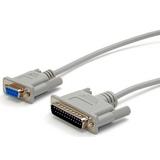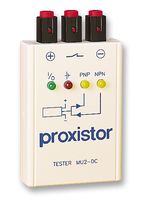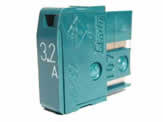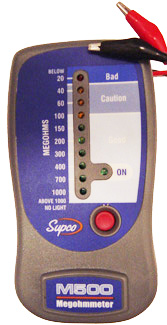What exactly is machine backlash? Ballscrew backlash, ballscrew slop, bearing backlash and more. |
|||
|
Backlash is any non-movement that occurs during axis reversals. Say, for instance, the X axis is commanded to move 1 inch in the positive direction. Immediately after this X movement, the X axis is commanded to move 1 inch in the negative direction. If any backlash exists in the X axis, then it will not immediately start moving in the negative direction, and the motion departure will not be precisely 1 inch. Backlash in the X or Y axis of machining centers is most obvious when milling full circles. If any backlash exists, there will be a nasty witness mark on each quadrant line (X+, X-, Y+ and/or Y- side of the circle). As you probably know, backlash is caused by normal usage, and checking for backlash (easily done with a dial indicator) should be part of your preventive maintenance program. There is a feature called backlash compensation that electronically compensates for backlash. However, this feature (commonly set by parameters) simply causes the control to add the amount of backlash to each axis reversal. While this improves positioning accuracy, it does nothing to minimize the excessive vibration a machine will experience when performing powerful machining operations if the axis drive systems are not rigid The best way to correct (at least with box way construction) is to adjust the machine's gibs to eliminate the backlash all together. When you must machine holes in precise X, Y locations (when finish boring, for example), backlash can cause positioning errors in hole locations if the motions required to machine the holes cause a reversal in axis direction. Consider, for example the series of X, Y motions to machine the holes in the work piece shown in Figure 1. As the boring bar moves from hole No. 1 to hole No. 2, it's moving in the X+ and Y directions. As it moves to hole No. 3, the Y axis experiences a reversal in direction. Any backlash in the Y axis will tend to shrink this Y-axis movement. Hole No. 3 will be out of position by the backlash amount. In similar fashion, the X axis is moving in the positive direction from holes No. 1 to No. 2 to No. 3. But during the X motion to hole No. 4, the X axis reverses direction. If there is any backlash in the X axis, the X distance between holes No. 1 and No. 3 will be different than the X distance between holes No. 4 and No. 5. Note that if it's properly adjusted, backlash compensation will eliminate this potential problem. One long-term way to minimize errors in positioning movements (especially for critical holes machined by boring bars), is to force the boring bar to approach the hole from the same direction in X and Y for every hole. For the most part, the direction from which the hole is approached is not too important. An exception might be a large horizontal machining center. Since the headstock moves to form the Y axis, and since it might be quite heavy if not properly counterbalanced, it would be wise to always approach from the negative Y direction. While the appropriate approach motion for each hole can be programmed long hand using simple motion commands, many controls have a special feature called single direction positioning that makes programming for this application very simple. Fanuc and Fanuc compatible machining center controls use a G60 word to specify the single direction positioning mode. Note that G60 is modal and must be canceled (with G64 with Fanuc controls) once you're done machining holes. The distance and direction for the approach is set by parameters (not programmable for most controls). For the machines we've seen, the amount of approach is commonly about 0.1 inch and the direction for the approach is from the negative direction in X and Y. Once installed, single direction positioning will alter all movements in X and Y. First, the boring bar will be sent to a position about 0.1 (on the negative side) from the coordinates in X, Y. Then the boring bar will be brought to the programmed coordinates. Even if there is some backlash in the X or Y axis, since all movements will be done in this fashion, the distances between the holes will be perfect. What is Backlash in relation to cnc machinery ?Figure 1 Take a large machine screw and thread a nut onto it. Now hold the head of the screw between the fingers of one hand and hold the nut between the finger of the other. If you push and pull on it as if you are trying to push the nut onto the bolt and then pull it off you’ll be able to feel a small amount of movement between the screw and the nut. This movement is the result of the fact that the threads of the nut do not fit snugly around the threads of the screw – there is some space in there. Figure 1 shows a hunk of threaded rod and a cutaway of a nut around it. You can see the space between the threads of rod and the threads of the nut. This space is called backlash. ****Backlash is a measurable quantity. The simplest way to measure it in a screw and nut is to push the nut as far as it will go in one direction and then to measure how far it can move in the other direction. Figure 2 shows the same cutaway diagram of the screw and nut with the nut pushed all the way to the left and the backlash distance shown.
Figure 2 The problem with backlash is that it can impose positioning error in a positioning system. For example, if the screw in figure 2 has five teeth per inch (5 TPI) and you turn the screw five times so that the nut moves to the right, the nut will move exactly one inch to the right. But starting from the position of the nut in figure 2, if you turn the screw five times so that the nut moves to the left, the nut will move one inch minus the amount of backlash. This is because the initial turning of the screw takes up the backlash but does not move the nut. The nut only moves after the screw has turned enough so its threads are bearing on the right side surfaces of the nut threads. This can be a problem in positioning systems that depend on a given number of rotations of the screw resulting in a given positioning of the nut. In cases where the amount of backlash is known and it is always known which side of the screw thread is contacting the nut thread it is possible to simply subtract out the backlash where appropriate. But as a practical matter such cases are rare. Backlash Compensation Methods1 - Software Backlash CompensationIn the introductory paragraphs it was mentioned that there are cases where the amount of backlash is known and it is always known which side of the screw thread is contacting the nut thread, and in these cases it is possible to simply subtract out the backlash where appropriate. This is the essence of software backlash compensation, which is offered by some of the computer software available to drive Computer Numerical Control (CNC) machines. If the machine you are designing is not a CNC machine than this would not be an option of course. The software works like this. When it is configured you specify the backlash of each of the linear positioning devices of your machine. The software knows which side of the nut thread that the screw thread is in contact with at all times. It “knows” this because it knows which way it turned the screw last. If it turns the screw in the same direction as it was last turned it knows there will be no backlash and so does no compensation. Whenever it turns the screw in the opposite way from the way it was last turned it knows it has to add enough turn of the screw to take up the backlash before it will actually start moving the nut and the carriage to which it is attached. Although such a scheme works fine in theory, movement of the carriage and nut that is not done explicitly by the positioning software can render this unworkable in actual practice. The conditions under which software backlash compensation will work are enumerated below. Note that all conditions must be met for it to work. The software must implicitly “know” which side the backlash is on before the software starts running. The general implications of this are that the initial starting position or home position must be moved to as a negative displacement.
2 - Preloading Most backlash reduction schemes involve mechanical pre loading of the nut for movement in both directions. In the examples above when the screw was actually driving the nut and carriage, the screw was driving the load of the carriage assembly. If it starts turning the other way it is unloaded until the backlash is taken up, at which point it begins driving the load of the carriage assembly the other way. Preloading, that is, imposing a load on both sides of the screw thread simultaneously even while it is not moving means there is never backlash that needs to be taken up. The generalized way to preload is to make sure the nut is in contact with both sides of the screw threads at all times. The most common way to do this is to use two nuts each in contact with one of the surfaces of the screw thread, as in figure 3. One way to do this is secure both nuts to the carriage in some way that allows adjustment of their position along the thread and some way to secure them once properly positioned. In practice such an arrangement has some problems when metal nuts are Ballscrew design for Minimill or smaller hobby type machines Another common way to preload the screw is to mount only one of the nuts to the carriage and have the other secured to the mounted nut by some linear slide mechanism that keeps it from spinning on the screw. The two nuts are then pushed apart (or pulled together) by a spring. The problem with this approach is that the spring force must exceed that presented by the load of the carriage assembly and this can cause considerable friction and wear of the screw and/or nut. Again, this is less of an issue with some plastic nuts. The advantage of this arrangement is that the assembly is self adjusting for wear. Another approach to self adjusting anti backlash nuts is similar to the two-nuts-and-a-spring approach above, but the two nuts are connected via a very steep pitched screw and nut assembly and positioned via a spring. This is the approach used in most commercially available anti backlash nuts. Ballscrew design for the Larger machines Many ballscrews which require a much higher load for many industrial size machine tools do not use the spring method with the two haves of the ballnut in order to remove the backlash. They generally are precision fitted and mounted solid to overcome the inertia and load carried by each of the axis. A spacer precision ground and placed between the two halves to remove the backlash. Once the spacer is ground down to the proper size the builder can then connect the two halves to keep the proper spacing. Then there is often a slot milled across the two halves of the ballscrew nut and a metal bar or Key stock bolted across the sides of the two piece nut to keep the two halves in place. Thank you for the donation of this detailed explanation of ballscrews and backlash. |
|||
Machine tool Backlash Check Program
|
|||









 used with metal screw, as tolerances of the screw and nuts, small positioning irregularities and expansion and contraction of the metal components with changes in temperature tend to make things bind up. But this can work surprisingly well when plastic nuts are used on a metal screw.
used with metal screw, as tolerances of the screw and nuts, small positioning irregularities and expansion and contraction of the metal components with changes in temperature tend to make things bind up. But this can work surprisingly well when plastic nuts are used on a metal screw.